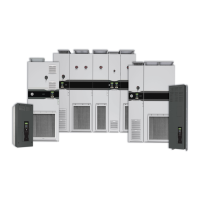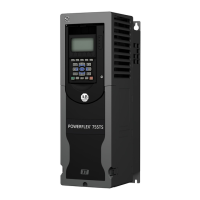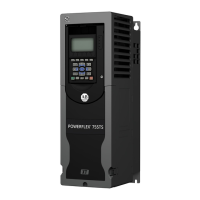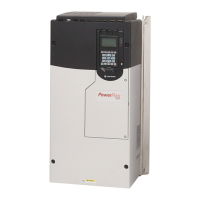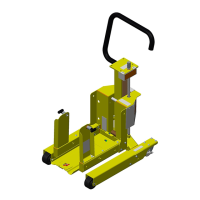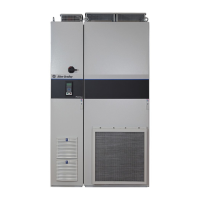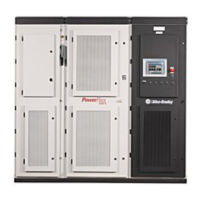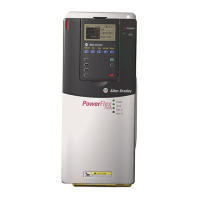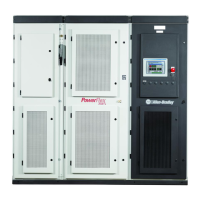32 Rockwell Automation Publication DRIVES-AT005D-EN-P - May 2022
Chapter 3 Shared DC Bus Configuration (Piggyback)
Precharge Interlocking
For more information about DC bus precharging and inverter precharging circuit configurations, see Precharge on page 11.
• If a disconnect switch is used between the common DC bus and the inverter DC input, the inverter must have precharging capability. In
addition, an auxiliary contact on the disconnect switch that opens when the disconnect is open must be wired to an inverter digital input. The
corresponding digital input must be assigned to the 'Precharge' enable function.
- PowerFlex 750-Series - assign to parameter 0:189 [DI Precharge]. See the PowerFlex 750-Series AC Drives programming manual,
publication 750-PM100
, for more information.
This configuration provides the proper precharge interlocking, which guards against possible damage to the drive when reconnecting the
drive to an energized DC bus.
• The precharge status of the PowerFlex 755TL/TR AC drive must be interlocked with the connected AC drives, such that the drives are
disabled (not running) when the PowerFlex 755TL/TR AC drive is in a precharge state. This interlocking can be accomplished by monitoring
bus supply line side converter parameter 13:225.25 [Line Side Sts 1]. This status bit can be connected to the PowerFlex 'Enable' control via
- hardwired bus supply I/O connection to inverter/drive local I/O
- Logix controller I/O
- communication DataLink within the Logix control program task.
Product may require optional I/O modules if hardwired interlocking methods are used.
AC Power System Resonance Conditions
PowerFlex 755TL/TR AC drives use active front end technology that is designed to reduce AC line harmonics introduced by the product. When AC
power is supplied by a dedicated isolation transformer, additional filtering devices are typically not required. When other non-linear loads, such as
6-pulse diode and thyristor converters used by conventional AC drives, share AC supply sources with PowerFlex 755T active front end products,
there can be interaction between the various filters that can cause power system resonance. This condition causes component stress, excess
heating, and can result in reduced product life. Because the interaction of each load must be considered, system resonance conditions are
challenging to predict.
If other non-linear loads, 6-pulse AC drives or active front end converters share the same AC source, it may be necessary to install a 3-phase line
reactor between the PowerFlex 755TL/TR AC drive input and the AC power source. For detailed information about power system resonance
conditions and mitigation techniques, see Knowledgebase Technote Power System Resonance Mitigation for PowerFlex 755TL/TR/TM
.
PowerFlex 755T active front end products monitor for line-side resonance currents. Detection is a key to help prevent unexpected power system
resonance failures. When system resonance is detected, the PowerFlex 755T active front end products continue operation and provide an early-
warning of line-side resonance through alarm 14117 'CapHighResonance'. When power system resonance levels surpass thresholds for reliable
operation, 14118 'CapOverResonance' provides a fault. You have the option to configure the desired response to a system over resonance
condition using parameter 0:453 [CapOvrRsncActn]. See the PowerFlex Drives with TotalFORCE Control Programming Manual, publication
750-PM100
, for more information.
DC Bus Termination
The frame size of the PowerFlex 755TL or PowerFlex 755TR drive determines how the secondary inverter is connected to the DC bus of the drive.
PowerFlex TL/TR Drives, Frames 5 and 6
Frames 5 and 6 come preinstalled with DC+/- terminals that give access to the DC Bus.
PowerFlex TL/TR Drives, Frame 7
Frame 7 isn’t supported at this time.
ATTENTION: Some PowerFlex AC drives have no external means of
controlling the precharge; therefore, a DC disconnect switch must not be
used. See Precharge on page 11
for more information.
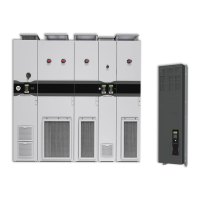
